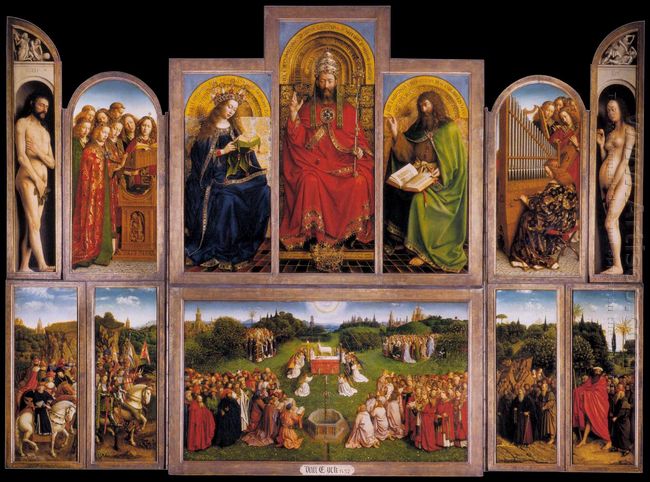The Ghent Altarpiece (1425-32), a beautiful oil painting by Great Netherland Artist Flemish master Jan Van Eyck (1390-1441), is a Netherlandish Renaissance Masterpiece located in the Cathedral of St Bavo in Ghent, Belgium. Regarded as one of the most famous paintings of any school or period, The Ghent Altarpiece has always been the core of a van Eyck’s front-page renown. Albrecht Durer, the great German master describe it as a stupendous piece of religious art and this verdict has been echoed by critics and artists for centuries.
This beautiful and mystical polyptych comprises twelve panels mounted on hinges, eight of which are painted on both sides, giving two very different views depending on whether they are open or closed. It’s imbued throughout with both spiritual and intellectual signification.
When opened, it portrays the communion of saints, which is “the new heaven and the new earth”, in the words of the Revelation of St John. Thus the central panel of the lower tier depicts the saints indicating the eight Beatitudes gathered around the altar where the sacrifice of the Lamb is proceeding, angels kneel, holding the emblems of His Passion. From left to right, in the foreground, are two processions facing each other. One of these is made up of the Old Testament patriarchs and prophets, and the other of figures from the New Testament. In the background are two other groups, facing one another as if they had just emerged from the surrounding jungle. A paradisiacal landscape runs through all five lower panels, uniting them in a work. In the middle of the upper tier is God Almighty, the Word, essence and origin of the universe. He is dressed in red and is crowned with a magnificent tiara. On his left is Mary and on his right, St John the Baptist. These central figures are surrounded by angels who are singing or playing instruments. At the far right and left of the composition separately are the figures of Adam and Eve. They were painted by Jan Van Eyck, and are set into trompe-l’oeil niches. Light and shadow play exquisitely over their forms which highlight as if they had been sculpted across-the-aboard.
Van Eyck’s grasp of light, surfaces and variations in material, which owed to his huge patience and attention to detail, gives the work its striking technical virtuosity. The Ghent Altarpiece exemplified the new Netherlandish approach to painting, in which the decorative idealization of the Byzantine and International Gothic tradition made concession to a more realistic rendering of both people and nature, based upon observation and study. As one of the greatest examples of early Flemish painting, the Ghent Altarpiece had a great impact not just on other Flemish artists but on painters across Europe. And it’s spoken well for its brilliance of colour and wide-ranging subject matter, which contains full-length nudes, vivid portrait art, landscapes, sumptuous robes and numerous examples of still life.
